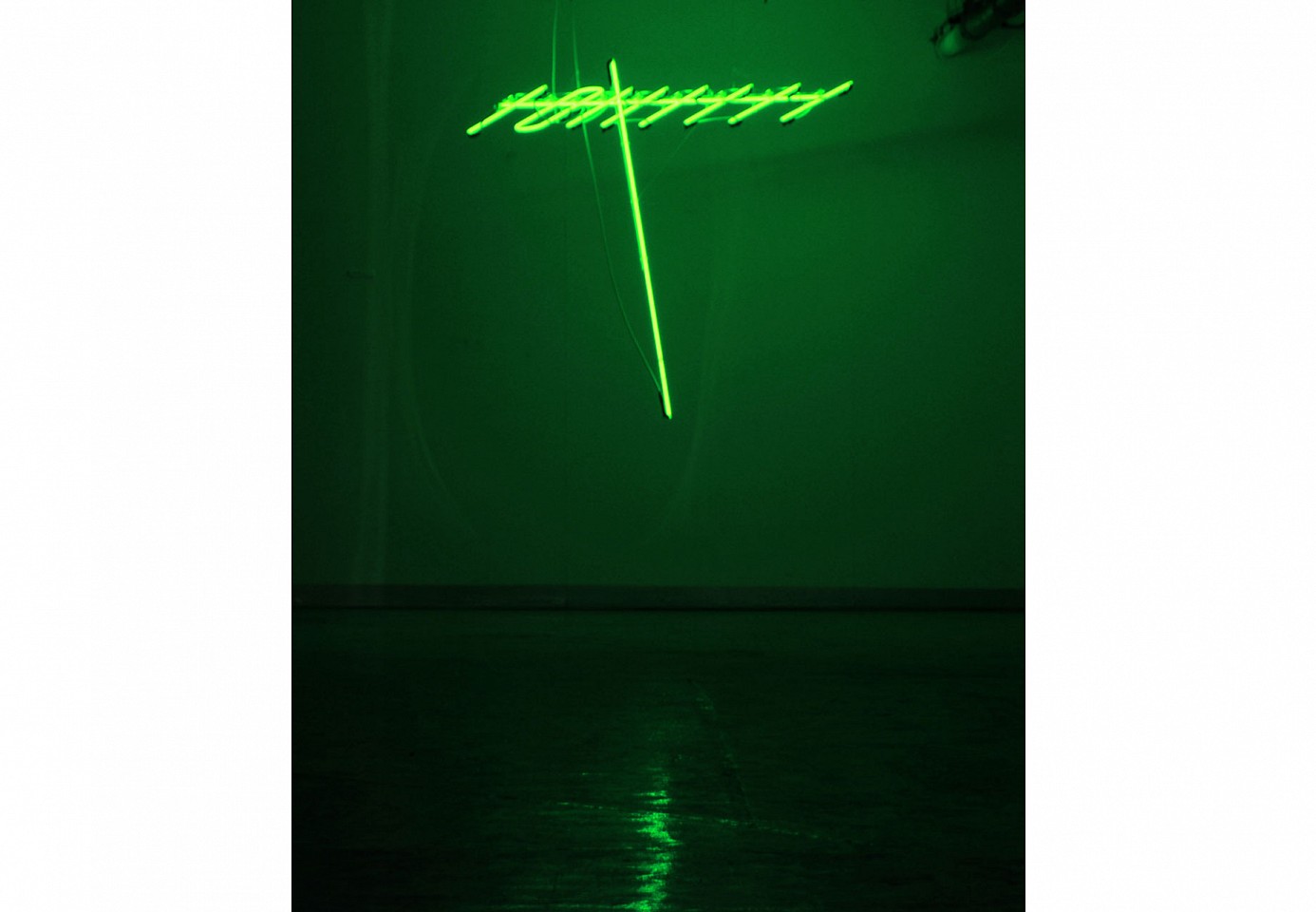Nasser Al Salem
Allah [He is the First and the Last](57:3), 2018
Video installation
Edition of 3 + 1 AP Duration: 7 min
Ahmed Mater
Antenna, 2010
Neon Tubes
150 x 150 x 50 cm (59 x 59 x 19 5/8 in.)
Edition of 2
AHM0008

2018, Video installation](/images/30130_h125w125gt.5.jpg)

Allah is a multimedia installation by artist Nasser Al-Salem and the second iteration derived from an earlier work by the artist. The visual manifestation of the word Allah is an abstracted representation in which its letters are stripped down to basic geometric lines and shapes. Nasser explores through a minimalist approach how form and light can imitate an approximate representation of the divine.
The artist radically eschews the conventional and traditionalist aesthetic appeal of a calligraphic form in representing Allah, and creating an immersive and experiential representation.
Light is the main medium in the work presented, alluding to Allah as the source of light. The work pushes beyond its literal readings of its medium to explore our perception of reality.
The work encases two mirrors, one on each side of the room, to blur the boarders between the physical and visual realms, and create an imaginary, infinite world.
The work explores the viewer’s assumptions of space by creating a visual and physical dissonance.
A Boy Stands on the flat, dusty rooftop of his family’s traditional house in the south west corner of Saudi Arabia. With all his reach he lifts a battered TV antenna up to the evening sky. He moves it slowly across the mountainous horizon, in search of a signal from beyond the nearby border with Yemen, or across the Red Sea towards Sudan. He is searching, like so many of his generation in Saudi, for ideas, for music, for poetry – for a glimpse of a different kind of life.
His father and brothers shout up from the majlis (sitting room) below, as music fills the house and dancing figures appear on a TV screen, filling the evening air with voices from another world. “This story says a lot about my life and my art” Ahmed tells me, as he installs a bright, white neon antenna into the ceiling of a warehouse gallery in Berlin. “I catch art from the story of my life,” he continues. “I don’t know any other way.”
Ahmed Mater is the boy with the antenna; a young explorer in search of contact with the outside world, reaching out to communicate across the borders that surround him. It is this spirit of creative exploration and curiosity that defines Ahmed’s journey as an artist.
The exhibition bases its foundation around Luminism and the relationship that the containment of light has between our environment and our engagement with it.
Renowned artists are showcasing seminal works, each treats light in a unique way allowing the viewer to immerse oneself into the light through variable formations and positioning. These installations of light are put together to exceed their material, thus allowing a flow of transcendent effects on the viewer, to steer and expand the human consciousness.
This experiential and interactive exhibition sets to subvert notions of light and space as we understand them, and the cross overs these may have in playing with our perceptions and psychology. All together are intended to explore the human visual perception, and how both light and color affect our emotions or change the way we feel within a space.
One artist creates a sensorial representation of unlimited possibilities of the imagination and of existence. These representation are created out of chaos—the experience of infinity within us.
While other artists explore color theory and pushes the boundaries of light to divide and redefine space all the while blurring the lines between each hue and indeed our visual perception of it.
Whether the gradual adjustment of color around one room renders it unperceivable, or if one is met with the sheer starkness of color in the next, they all require the reliable rendering of the eye to distinguish the stability of the space and the accuracy of the color of the original environment.
What is experienced depends on their physical positioning within the space, coupled with their own psychological state and visual perception. The ephemeral nature of transitory light shifts the stability within our understanding of 3 dimensional space as we have grown to know it, allowing for a new perception of how we view our surrounding reality to be created.
Participating artists: Ahmed Mater, Anne Senstad, Carlos Cruz-Diez, James Turrell, Leo Villareal, Nasser Al Salem, and Robert Irwin.
This exhibition is in collaboration with Pace Gallery.

</i></span>, <span class="viewer-caption-year">2018</span></p>
<p><span class="viewer-caption-media">Video installation</span></p>
<p><span class="viewer-caption-description">Edition of 3 + 1 AP
Duration: 7 min</span></p>
<p><span class="viewer-caption-aux"></span></p>](/images/30130_h960w1600gt.5.jpg)





